Abstract
The plantar plate is the fibrocartilaginous structure that supports the ball of the foot, withstanding considerable compressive and tensile forces. This study describes the morphology of the plantar plate in order to understand its function and the pathologic disorders associated with it. Eight lesser metatarsophalangeal joint plantar plates from three soft-embalmed cadavers (74–92 years, two males, one female), and eight lesser metatarsophalangeal joint plantar plates from a fresh cadaver (19-year-old male) were obtained for histology assessment. Paraffin sections (10 μm) in the longitudinal and transverse planes were analyzed with bright-field and polarized light microscopy. The central plantar plate collagen bundles run in the longitudinal plane with varying degrees of undulation. The plantar plate borders run transversely and merge with collateral ligaments and the deep transverse intermetatarsal ligament. Bright-field microscopic evaluation shows the plantar aspect of the plantar plate becomes ligament-like the further distally it tapers, containing fewer chondrocytes, and a greater abundance of fibroblasts. The enthesis reveals longitudinal and interwoven collagen bundles entering the proximal phalanx with multiple interdigitations. Longer interdigitations centrally compared to the dorsal and plantar aspects suggest that the central fibers experience the greatest loads.






Similar content being viewed by others
References
Benjamin M, Ralphs JR (1998) Fibrocartilage in tendons and ligaments—an adaptation to compressive load. J Anat 193:481–494
De Carvalho HF (1995) Understanding the biomechanics of tendon fibrocartilages. J Theor Biol 172:293–297
Coughlin MJ (1989) Subluxation and dislocation of the second metatarsophalangeal joint. Orthop Clin North Am 20:535–551
Coughlin MJ (2000) Common causes of pain in the forefoot in adults. J Bone Joint Surg 82:781–790
Davies MS (2005) Muscles and fascia of the foot. In: Standing S (eds) Gray’s anatomy. The anatomical basis of clinical practice, Elsevier, London, p 1509
Deland JT, Lee KT, Sobel M, DiCarlo EF (1995) Anatomy of the plantar plate and its attachments in the lesser metatarsal phalangeal joint. Foot Ankle Int 16:480–485
Le Graverand M, Ou Y, Shield-Yee T, Barclay L, Hart D, Natsume T, et al (2001) The cells of the rabbit meniscus: their arrangement, interrelationship, morphological variations and cytoarchitecture. J Anat 198:525–535
Johnston RB, Smith J, Daniels T (1994) The plantar plate of the lesser toes: An anatomical study in human cadavers. Foot Ankle 15:276–282
Ker RF (1999) The design of soft collagenous load-bearing tissues. J Exp Biol 202:3315–3324
Lewis AR, Nolan MJ, Hodgson RJ, Benjamin M, Ralphs JR, Archer CW, et al (1996) High resolution magnetic resonance imaging of the proximal interphalangeal joints. Correlation with histology and production of a three-dimensional data set. J Hand Surg 4:488–495
Messner K, Gao J (1998) The menisci of the knee joint. Anatomical and functional characteristics, and a rationale for clinical treatment. J Anat 193:161–178
Mohana-Borges AV, Theumann NH, Pfirrmann CW, Chung CB, Resnick DL, Trudell DJ (2003) Lesser metatarsophalangeal joints: Standard MR imaging, MR arthroraphy, and MR bursography—initial results in 48 cadavers. Radiol 227:175–182
Petersen W, Petersen F, Tillmann B (2003) Structure and vascularization of the acetabular labrum with regard to the pathogenesis and healing of labral lesions. Arch Orthop Trauma Surg 123:283–288
Stainsby G (1997) Pathological anatomy and dynamic effect of the displaced plantar plate and the importance of the integrity of the plantar-plate-deep transverse metatarsal ligament tie-bar. Ann R Coll Surg Engl 79:58–68
Umans HR, Elsinger E (2001) The plantar plate of the lesser metatarsophalangeal joints. Potential for injury and role of MR imaging. Clin North Am 3:659–669
Vogel KG (1995) Fibrocartilage in tendon: A response to compressive load. In: Gordon SL, Blair SJ, Fine LJ (eds) Repetitive motion disorders of the upper extremity, American academy of orthopaedic surgeons, Rosemont, pp 205–215
Yu GV, Judge MS, Hudson JR, Seidelmann FE (2002) Predislocation syndrome. Progressive subluxation/dislocation of the lesser metatarsophalangeal joint. J Am Podiatr Med Assoc 92:182–197
Acknowledgments
Victorian Institute of Forensic Medicine for the provision of the cadaver, and Mr. I. Boundy for histology services.
Author information
Authors and Affiliations
Corresponding author
Rights and permissions
About this article
Cite this article
Gregg, J., Marks, P., Silberstein, M. et al. Histologic anatomy of the lesser metatarsophalangeal joint plantar plate. Surg Radiol Anat 29, 141–147 (2007). https://doi.org/10.1007/s00276-007-0188-2
Received:
Accepted:
Published:
Issue Date:
DOI: https://doi.org/10.1007/s00276-007-0188-2




